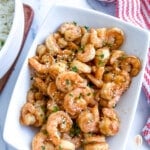Blackstone Hibachi Shrimp
Hibachi Shrimp has an amazing grilled exterior and succulent center! Make this 30-minute Blackstone hibachi recipe for a delicious meal!
Servings: 4
Calories: 249kcal
Equipment
- Blackstone hibachi or other flat top griddle or stove top griddle pan
- 2 large metal spatula
- small prep bowls
- small balloon whisk
- Infrared thermometer to measure the temperature of your cooking surface
Ingredients
- 3 tablespoons low-sodium soy sauce or regular soy sauce
- 3 tablespoons mirin *See Notes for substitutes
- ½ teaspoon ground black pepper
- 1 teaspoon toasted sesame oil or other high smoke point oil (ex: peanut, avocado, or grape seed)
- 2 tablespoons butter clarified butter, or ghee
- 1 tablespoon minced garlic (2 small cloves)
- 2 pounds raw shrimp peeled and deveined *See Notes
Instructions
- Preheat a Blackstone hibachi griddle or a griddle pan over medium high heat to 400°F. *The best way to determine the temperature of the flat top is with an infrared temperature gun.
- To a small prep bowl, add soy sauce, mirin (or substitute), and black pepper. Whisk to combine, then set aside.
- Add the sesame oil and butter to surface of the hibachi, then use a large spatula to spread it out over the cooking surface. When the butter has melted, add the garlic and sauté until fragrant, about 30 seconds.
- Add shrimp to the griddle, then use the spatula again to stir and combine the shrimp with the melted garlic butter mixture. Pour soy sauce mixture over the shrimp, then use your spatula to stir and combine again.
- Cook the shrimp, stirring and flipping occasionally, for 4-6 minutes, or until it turns pink and is no longer translucent.
- Remove shrimp from the griddle and serve warm with rice, fried rice, or noodles of choice.
Video
Notes
- For example, the only way to truly determine the temperature of the Blackstone is with an infrared temperature gun. When dealing with multiple ingredients and phases of cooking, it’s a lifesaver!
- Shrimp - The best sizes of shrimp to use for hibachi cooking are large or jumbo. Smaller sizes tend to overcook quickly. You can leave the shrimp tails on or remove them, whichever you prefer - tails are easier to remove after cooking. Frozen shrimp may be used, but will first need to be thawed in the refrigerator, or in a colander under cold running tap water. Be sure to pat the wet shrimp dry with paper toweling.
- Mirin - This ingredient is fermented rice wine. Good substitutes with alcohol are sake or sweet marsala wine. For a non-alcoholic mirin substitute, use 3 tablespoons rice wine vinegar combined with 2 teaspoons honey or 1 tablespoon sugar.
- Spicy Hibachi Shrimp - Add ½ teaspoon of crushed red pepper flakes or a drizzle of sriracha to the soy sauce mixture for a spicy kick.
- Citrus Garlic Hibachi Shrimp - Stir 1–2 tablespoons of fresh lemon or lime juice into the sauce for a bright, tangy flavor that complements the garlic butter.
- Teriyaki Hibachi Shrimp - Replace the mirin and soy sauce with ¼ cup of teriyaki sauce, and sprinkle sesame seeds over the cooked shrimp for a sweeter, glaze-like finish.
- Hibachi shrimp can be refrigerated for up to 4 days.
- Reheating on the stovetop, to revive the texture and not overcook the shrimp, is the best way to go. We also suggest reheating separately from any rice or vegetables as it warms very quickly.
- Microwaving is also possible, but don’t overdo it! Heat them in short, 15-second rounds to avoid giving the flesh a rubbery texture.
Nutrition
Serving: 6 shrimps | Calories: 249kcal | Carbohydrates: 9g | Protein: 32g | Fat: 9g | Saturated Fat: 4g | Polyunsaturated Fat: 1g | Monounsaturated Fat: 2g | Trans Fat: 0.2g | Cholesterol: 301mg | Sodium: 1859mg | Potassium: 312mg | Fiber: 0.2g | Sugar: 3g | Vitamin A: 585IU | Vitamin C: 1mg | Calcium: 132mg | Iron: 1mg
